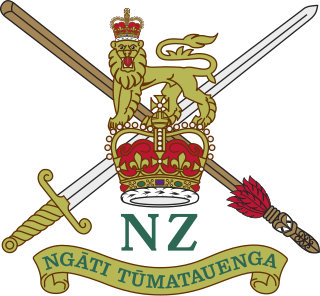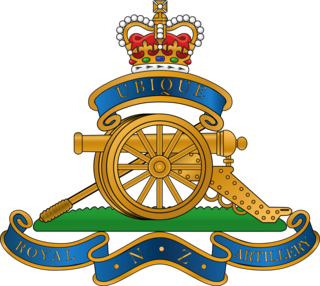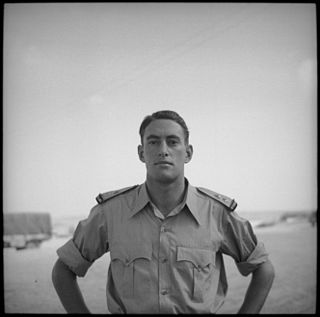
The New Zealand Army is the principal land warfare force of New Zealand, a component of the New Zealand Defence Force alongside the Royal New Zealand Navy and the Royal New Zealand Air Force.

The Royal Regiment of New Zealand Artillery is the artillery regiment of the New Zealand Army. It is effectively a military administrative corps, and can comprise multiple component regiments. This nomenclature stems from its heritage as an offshoot of the British Army's Royal Artillery. In its current form it was founded in 1947 with the amalgamation of the regular and volunteer corps of artillery in New Zealand. In 1958 in recognition of services rendered it was given the title the Royal Regiment of New Zealand Artillery.

The 3rd Field Regiment, Royal New Zealand Artillery was a territorial force Field Artillery regiment of the New Zealand Army. The unit was formed in 1921 and consisted of the field artillery batteries based in the South Island. The regiment remained in New Zealand during the Second World War and was tasked with training reinforcements for 2nd New Zealand Expeditionary Force. The regiment was disbanded in 1990.

The 5th Light Regiment Royal Regiment of New Zealand Artillery was a unit of the New Zealand Divisional Artillery. It was formed in 1952 to provide each of the division's brigades with a supporting mortar battery. The regiment contained members of both the Territorial and Regular Forces and had its headquarters in Wellington and batteries in Petone, Napier and Gore. It moved to Southland in 1956 and was headquartered in Invercargill. The Regiment was disbanded in 1964 as part of a reorganisation of the New Zealand Army's artillery units.

The 11th Coast Regiment, Royal New Zealand Artillery was a territorial coastal artillery regiment of the New Zealand Army based at Godley Head. The regiment was formed in 1940 as 11th Heavy Regiment, New Zealand Artillery and controlled the coastal defence batteries around Lyttleton Harbour. The regiment was progressively expanded and by the end of the war had batteries all over the upper North Island. The regiment was reduced to a cadre in 1957 and disbanded in 1967, along with the other coastal artillery regiments.
The 5th Division, New Zealand Military Forces, was raised in the Southern Military District during the Second World War. It consisted of the 3rd and 10th Brigades and the 11th Brigade Group. It was disbanded after the danger of invasion from Japan receded. It appears to have been raised on 1 November 1941, and disbanded on 1 April 1944.

Lieutenant General Sir Leonard Whitmore Thornton, was a senior officer in the New Zealand Army.

The 1st Brigade is currently the largest unit of the New Zealand Army, and contains most of the army's deployable units. The brigade was formed on 13 December 2011 by amalgamating the 2nd Land Force Group and 3rd Land Force Group. Its establishment formed part of the 'Army 2015' package of reforms.
The 1st Division was one of three New Zealand Army home defence divisions formed during World War II. The unit was established on 1 November 1941 and was responsible for protecting the northern region of New Zealand's North Island from invasion. The 1st Division was placed on alert during the early months of the Pacific War, but no threat developed. The division was greatly reduced in size during 1943 and was disbanded on 1 April 1944.
The 4th Division was one of three home defence divisions of the New Zealand Military Forces formed during World War II. The unit was established on 1 November 1941 and was responsible for protecting the southern part of New Zealand's North Island from invasion. The division was greatly reduced in size during 1943 and was disbanded on 1 April 1944 without seeing combat.
The Shropshire Royal Horse Artillery was a Territorial Force Royal Horse Artillery battery that was formed in Shropshire in 1908 from the Shropshire Battery of the 1st Shropshire and Staffordshire Artillery Volunteers, Royal Garrison Artillery of the Volunteer Force. It saw active service during the First World War on the Western Front in 1917 and 1918 as part of an Army Field Artillery Brigade. A second line battery, 2/1st Shropshire RHA, also served on the Western Front in 1917 and 1918 as part of another Army Field Artillery Brigade. It was reconstituted post-war as a medium artillery battery and served as such in the Second World War.

The 4th Medium Regiment, Royal New Zealand Artillery was a territorial artillery regiment of the New Zealand Army based in the Waikato. It was formed in 1948 and initially equipped with 6 inch howitzers, although these were replaced with 5.5 inch guns in 1951. The regiment received the freedom of the city of Hamilton, New Zealand in 1960 and bore the city's coat of arms on their guns. The regiment was disbanded in 1961.

The 12th Heavy Anti-Aircraft Regiment, Royal New Zealand Artillery was a territorial air defence regiment of the New Zealand Army. It was formed in 1956 from the heavy batteries of the 13th and 14th Composite Anti-Aircraft Regiments, based in Auckland and Wellington respectively, as well as an independent battery based in Christchurch. The 12th Heavy Anti-Aircraft regiment was disbanded in 1961.

The 13th Composite Anti-Aircraft Regiment, Royal New Zealand Artillery was a territorial air defence regiment of the New Zealand Army. The regiment was formed in 1948 and disbanded in 1956, with its heavy battery being transferred to the newly formed 12th Heavy Anti-Aircraft Regiment.

The 14th Composite Anti-Aircraft Regiment, Royal New Zealand Artillery was a territorial air defence regiment of the New Zealand Army. The regiment was formed in 1948 and disbanded in 1956, with its heavy battery being transferred to the newly formed 12th Heavy Anti-Aircraft Regiment.

The 15th Composite Anti-Aircraft Regiment, Royal New Zealand Artillery was a territorial air defence regiment of the New Zealand Army. The regiment was formed in 1948 and disbanded in 1954. Its heavy battery briefly became an independent unit, before becoming part of the newly formed 12th Heavy Anti-Aircraft Regiment in 1956.

The 2nd Field Regiment, Royal New Zealand Artillery was a territorial field artillery regiment of the New Zealand Army. It was originally formed as 2nd Field Artillery Brigade in 1921 and brought the independent batteries of the Wellington area under a single command. In 1940, the New Zealand territorial artillery brigades were redesignated as regiments and the former batteries became troops within new, larger batteries. During the Second World War, the 2nd Field Regiment remained in New Zealand for home defence as part of the 4th Division. After the war, the regiment remained a part of the territorial force until it was disbanded in 1964. The regiment was briefly reformed in 1982 to provide command support to 22(D) Battery, but was disbanded the next year.

The 10th Coast Regiment, Royal New Zealand Artillery was a territorial coastal artillery regiment of the New Zealand Army. The regiment was formed in 1940 as 10th Heavy Regiment, New Zealand Artillery and controlled the coastal defence batteries around Wellington Harbour. The regiment was progressively expanded and by the end of the war had batteries all over the lower North Island. The regiment was reduced to a cadre in 1957 and disbanded in 1967, along with the other coastal artillery regiments.

The 9th Coast Regiment, Royal New Zealand Artillery was a territorial coastal artillery regiment of the New Zealand Army. The regiment was formed in 1940 as 9th Heavy Regiment, New Zealand Artillery and controlled the coastal defence batteries around Auckland. The regiment was progressively expanded and by the end of the war had batteries all over the upper North Island. The regiment was reduced to a cadre in 1957 and disbanded in 1967, along with the other coastal artillery regiments.

The Hawke's Bay Regiment was a territorial infantry regiment of the New Zealand Military Forces. The regiment traced its origins to the Napier Rifle Volunteer Rifles, a volunteer corps formed in 1863 and which would later amalgamate with other volunteer corps to form the 9th Regiment in 1911. During the First World War, the regiment provided a company to each of the battalions of the Wellington Infantry Regiment and saw combat at Galipolli and on the Western Front. After the war the regiment was renamed the Hawke's Bay Regiment and remained in New Zealand for home defense during the Second World War. Men from the regiment, however, served with the 19th, 22nd, 25th and 36th Battalions of the Second New Zealand Expeditionary Force. The regiment had a close relationship with the Ruahine Regiment, which was detached and reabsorbed by the Hawke's Bay regiment on two separate occasions. In 1964, the Hawkes Bay regiment was amalgamated with the Wellington Regiment and become the 7th Battalion, Royal New Zealand Infantry Regiment






